The Joy of Leaving the Secular World
Sanghwanam and Bokcheonam Hermitages of Beopjusa Temple on Mt. Songnisan
Text by. Seong Jae-heon Photo by. Ha Ji-kwon
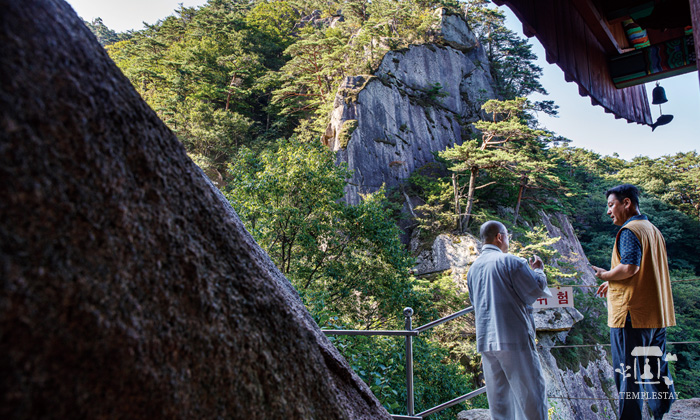
In the pitch-black before dawn, I left my house as soon as I opened my eyes. Heading to Mt. Songnisan, (lit. a mountain far from the secular world), I somehow felt like I had found an emergency exit in a burning building. In the Lotus Sutra, the Buddha said, “This world is like a house on fire.” It is indeed so. Life in the secular world is a fierce battle for survival, with all sorts of dangers and disasters lurking everywhere to threaten our humble lives. That is why the Buddha told us to quickly leave this burning house. Where is the peaceful land of nirvana that is free from anxiety and fear? Even if it is not nirvana, where eternal peace and comfort are guaranteed, I wish there was a place where I could at least escape the flames and smoke for a moment. Could Mt. Songnisan be such a refuge?
As the darkness subsided and the sun began to rise, I left the highway and turned onto a quiet country road.
After driving for a while, I had to turn again and again to navigate many switchbacks. Rocks jutting out from the dense pine forests, no people, and only the sound of the flowing stream and a cool breeze filled the air. Is this what a fairyland looks like? I drove past the well-known Udang House in Jangan-myeon, a small bus stop next to the valley, and the pine trees in Seowon-ri. As I kept stopping to admire these leisurely scenes that caught my eye, the world I had left behind grew more distant.
I drove around the villages of Hapan-ri and Jungpanri, and climbed up to Sangpan-ri, where I saw the Jeongipumsong (Minister Pine) standing in the middle of a small field. It had a dignified and stately appearance, a look it had acquired over the past 600 years. I stopped again and walked around the pine tree. It was like meeting a scholar who had endured much hardship but whose spirit was still unshakeable; or like a sage who possessed secret wisdom and only smiled. I felt naturally humbled standing before it.
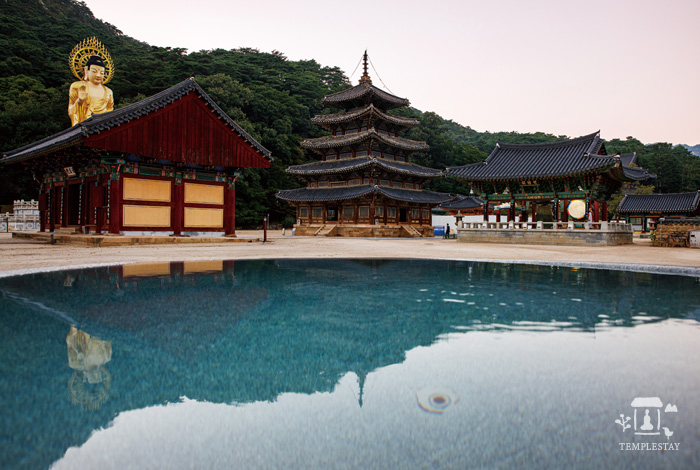
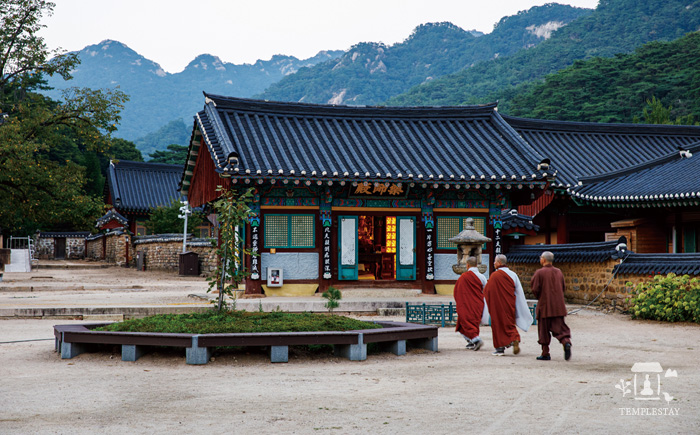
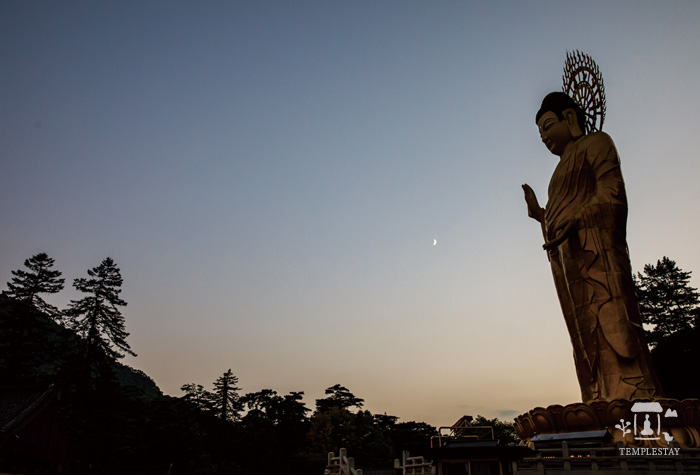
When I arrived at Beopjusa Temple, my hiking companion was already there waiting for me. I hurriedly put on my backpack and we set off. Ven. Director of Dharma Propagation volunteered to be our guide, perhaps worried about this being our first time on this trail. The trail was well-maintained and easy to walk on. There was a sign at the trailhead that said, “Sejo-gil Trail.” King Sejo was not well liked by Confucian scholars. They considered him evil because he deposed his nephew King Danjong to seize the throne. But Buddhists had a different opinion. King Sejo revered Buddhism to the point of declaring himself a pro-Buddhist sovereign, and he was an avid reformer who strove to improve the lives of his people. This trail was probably named after him to commemorate his visit to Bokcheonam Hermitage during his reign.
As I walked, I saw a “bathing pool” on the right. There is a legend that King Sejo bathed here, and afterward, his boils were cured. When he first came from the palace in Hanyang to the mountains, his body was covered with boils, so his mind was probably in distress. Although the bathing pool was filled with clear mountain water, my attitude was somehow bitter around it.
Humans are truly unpredictable. Who would have thought that King Sejo, who was trusted by the royal family and the government, would poison his nephew? When he was a prince, he participated in the creation of Hangeul (Korean alphabet) and had shared many experiences (both good and bad) with the scholars of Jiphyeonjeon, eating and celebrating together. Who would have thought that he would behead Seong Sam-mun, a loyal Confucian minister? “Where should we go now?” we wondered.
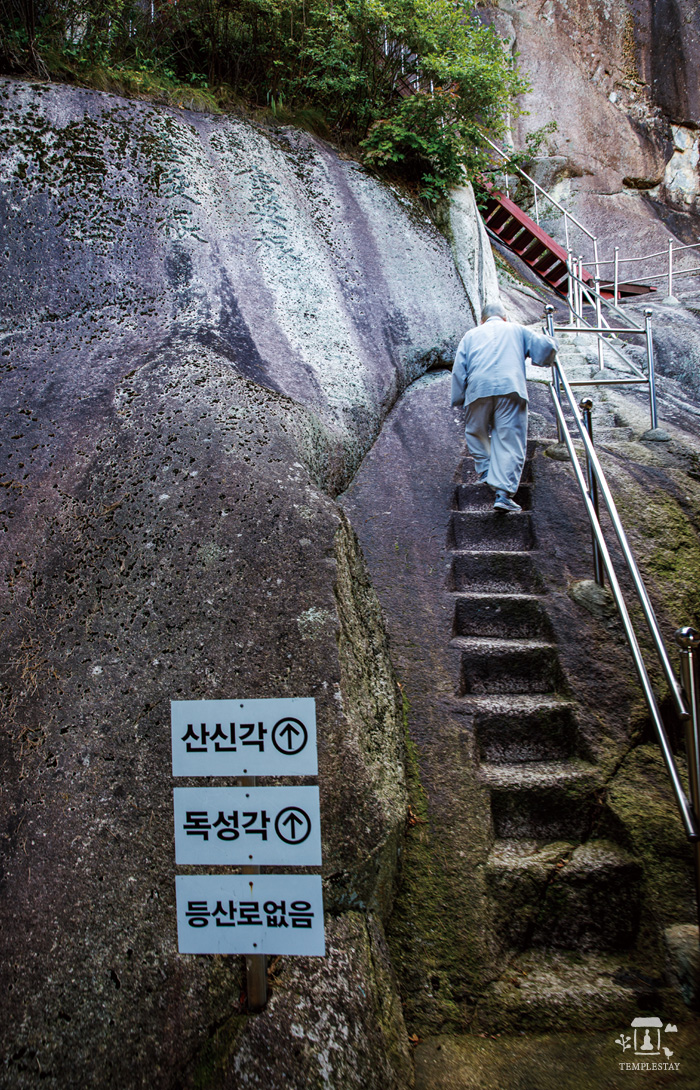
When I reflect on my life, am I the only one filled with regret and disappointment? People flocked to see King Sejo from all sides in pursuit of wealth and power, but he too must have felt lonely. Everyone bowed to him and tried to please him with flattery, but he must have missed not having friends. That could have been why he came to this distant place.
When I was in college, I once took a night bus from Seoul and climbed Mt. Seoraksan alone. At that time, I thought that loneliness was romantic. I climbed the fog-covered mountain, using the voices of other people to guide me. Then I got lost, and when I couldn’t hear anything in the pitch-black darkness, I became afraid. I wandered around here and there until I collapsed in exhaustion. Suddenly, I missed people. Upon reflection, I realized that as I aged, I chose different kinds of friends. When I was little, I wanted friends to play with, and when I became an adult, I wanted friends who were smart and capable. Now, I want friends who will be there for me when I feel exhausted by life.
Sanghwanam Hermitage, at the End of the Steep Mountain Path
While I was reflecting on my distant past, I saw a sign that said Sesimjeong, literally meaning “a pavilion to cleanse the mind.” I thought the name was really cool. There was a mortar for grinding grain carved into a large rock, and next to it, I saw an A-frame. I was curious because it is rare to see one these days. I asked the monk who was our guide.
“Venerable, what is this A-frame used for?”
“That? It’s used to carry daily necessities to a mountain hermitage inaccessible by car.”
“Is there a hermitage around here?”
“Yes, the path on the right goes to Sanghwanam and Sangguam Hermitages. There is a legend that Joseon’s founder, King Taejo, prayed at Sanghwanam. So, King Sejo followed in his footsteps and visited Sanghwanam first on his way to Bokcheonam Hermitage. Should we also stop by Sanghwanam?”
My eyes went to where the monk was pointing, and I saw a steep stone stairway. At first glance, it looked difficult, and I wondered, “Oh my, will we ever get there?” But I just smiled and uttered, “Of course, Venerable.”
As expected, the path was rough and steep, but also really amazing. As I walked along the winding mountain path, sweating profusely, my body and mind naturally began to feel lighter. And before I knew it, we arrived at Sanghwanam (lit. Hermitage of the Ultimate Joy). It was built by piling up stones to make retaining walls under the cliffs on three sides and by leveling a small plot of land.
I felt refreshed after drinking a ladleful of spring water. After paying my respects in the hermitage’s main hall, I looked back and saw a Sansingak (Shrine of Mountain Spirits) attached to the steep cliff like a swallow’s nest. As I climbed the iron stairs to reach it, my eyes were dazzled by the wide-open view.
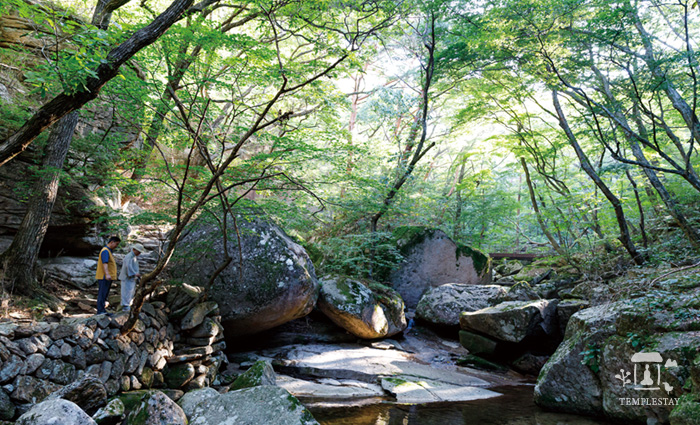
“Could this be the ultimate joy?”
The ridges of Mt. Songnisan flowed down like waves, seeming to wrap around me in layers. I felt warm and comfortable, as if I was being held in my mother’s arms. All I could see was clear sky and green pine trees, and all I could hear was the sound of water and birds. I was lost in this beautiful scenery for some time, and then asked our guide, “Why did the monks of old settle in such remote places?”
He laughed heartily, and said, “Does human greed easily disappear? When you have one thing, you want two. That is the human heart. The Buddha said, ‘Be content with small things and live with self-restraint,’ but how is that easily done? I have been a monk for over 30 years. However, as the saying goes, “opportunity makes the thief.” When there is something good within reach, I feel greed arising. So, until your Buddhist practice matures, it is best to stay far away from things that might incite greed.”
His sincerity refreshed my heart. We left Sanghwanam behind and headed back to Bokcheonam Hermitage. The smell of the earth, dried by the autumn sun, was fragrant.
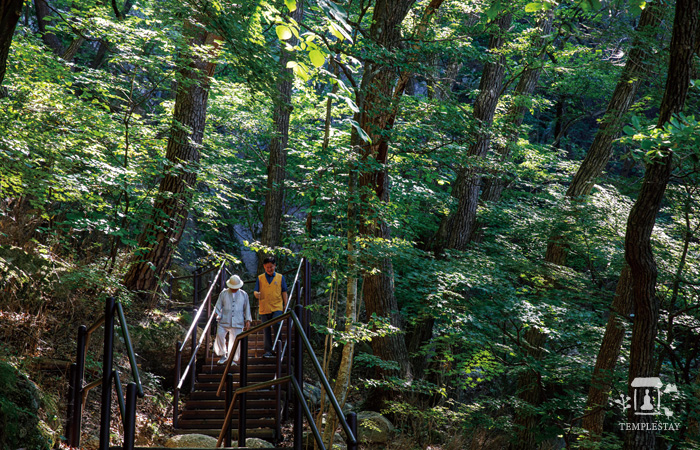
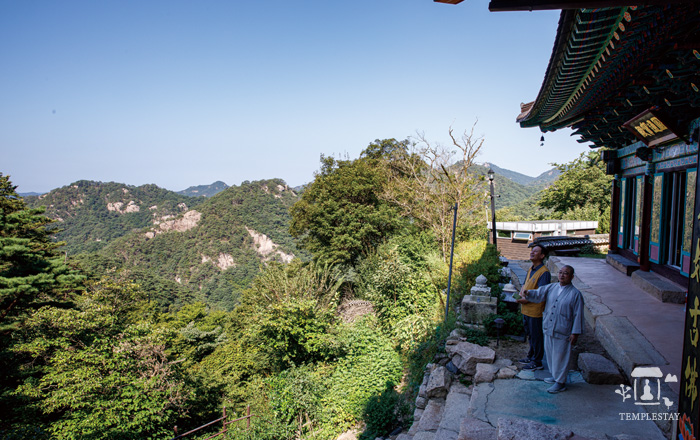

Our guide continued speaking, “Look at those fallen trees. Don’t they quietly blend in? Thanks to them, new trees can grow healthy. We need to learn from nature. People also need to know how to quietly step aside when the time comes and make room for those who come after.”
Yes, humans live in conflict with the natural laws that are so obvious. The same is true of me. When I reflect on my life, my chaotic thoughts and frustrated heart all come from not being able to see the obvious. While listening to our guide’s simple, clear words, we arrived at Bokcheonam before I knew it.
Bokcheonam is a historic hermitage founded during the reign of Silla’s King Seongdeok. The reason King Sejo visited Bokcheonam was to see Master Sinmi and his two disciples, Hangnyeol and Hakjo. When he was a prince, King Sejo helped his father, King Sejong, in creating Hangeul, and when his mother, Queen Soheon, passed away, he compiled the Buddhist scriptures in Hangeul. It was titled Seokbosangjeol (Genealogy of Shakyamuni) and was written to pray for the repose of her soul.
After he ascended to the throne, he established the Office of Publication of Buddhist Scriptures, and translated many Buddhist texts into Hangeul. The people who helped him the most were Master Sinmi and his two disciples. Therefore, we can regard Master Sinmi as King Sejo’s teacher, and Vens. Hangnyeol and Hakjo as his dharma friends who shared the same vision.
The Annals of the Joseon Dynasty recorded the events of that day as follows:
“On February 28, the 10th year of King Sejo’s reign (1464), the king visited Songnisa Temple and Bokcheonsa Temple. He granted Bokcheonsa Temple 300 seok of rice, 30 slaves, and 200 gyeol of land. He granted Songnisa Temple 30 seok of rice and beans, and returned to the temporary palace around 3-5pm.”
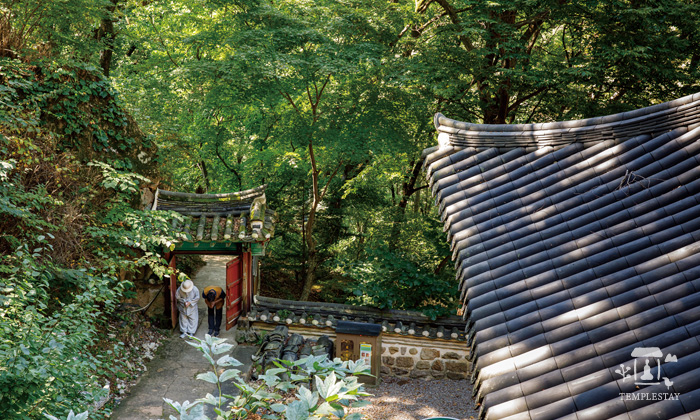
One gyeol of land is equal to one hectare (ha) or 3,000 pyeong today, and he donated 600,000 pyeong of farmland to Bokcheonsa Temple. Although it is not a very splendid hermitage today (it burned down and was rebuilt several times), it must have been enormous at the time.
On the rock behind the hermitage, the words “Bokcheon (lit. Spring of Happiness)” are inscribed, now covered with greenish moss after so many years. A spring constantly gushes from cracks in the rock. Bokcheonsa is truly a temple that has led countless people to the land of happiness. I thought of the many great monks who probably drank from this spring: Sinmi and Hakjo long ago, and more recently, Gyeongheo, Mangong, Hyobong, Seongcheol, and Gwaneung. My heart naturally felt great piety. I scooped up a ladle of spring water, held it with both hands, drank it slowly, and made a wish.
“May this water help wisdom grow and bear the fruit of happiness.”
I paid my respects at the monks’ stupas of Vens. Sinmi and Hakjo on the mountain ridge on the right, and slowly descended to Beopjusa Temple walking around the lake. As I entered the temple, I could smell a sweet caramel scent from somewhere. I stopped and looked around, and saw that Mr. Ha, who had accompanied me, had noticed it too. He said with a smile, “It’s the scent of a laurel tree, that one.”
I followed the scent and sat down on a bench under the laurel tree. When I looked up, I saw yellow oval-shaped leaves dancing in the autumn sunlight. I was so impressed with the color and scent that I sat there for a while, my mind a blank. Then, I found myself smiling without realizing it.
“Is happiness something special? This is happiness.”
Seong Jae-heon served as a sutra translator at the Dongguk Institute of the Tripitaka and is currently working as a member of the translation committee for the Collected Works of Korean Buddhism. He participated as a member of the Jogye Order's writing committee for Life of the Buddha and Introduction to Buddhism for Youth. His books published in Korean include Coffee and Dharma and People Who Have Met the Buddha.
Beopjusa Temple
+82-54-432-2652
http://www.beopjusa.org/




